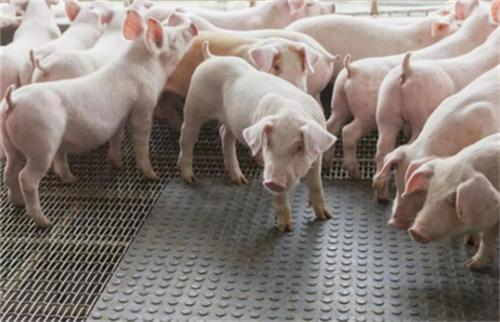There are six possibilities for a large number of bleeding spots in pig skin, do you know?
In pig production, it is often seen that there are a large number of or even systemic bleeding spots in the skin of pigs at various stages, mostly in the neck, back and abdomen, medial thigh and medial axils of pigs. So what is the cause of these subcutaneous bleeding spots in pigs?

Mycotoxin poisoning
Mycotoxin poisoning has the characteristics of chronic poisoning! The mycotoxin that can directly cause skin bleeding is mainly black grape mycotoxin. There are bleeding spots on the glabrous or hairless skin. Another common clinical skin bleeding occurs in breeder pigs, especially in postpartum sows and older boars. There are a large number of bleeding spots along the midline of the back in the neck and back of the pigs, which become dense needle black spots for a long time, but the appetite and body temperature of the affected pigs are normal. Eperythrozoonosis is often mistaken for eperythrozoonosis and must be carefully identified.
Prevention and control measures of mycotoxin: turn off the feed, use mildew remover reasonably, and repair the damaged immune system.
2. Allergic reaction
Allergens can stimulate the skin to develop dermatitis and eczema, and the surface tissue of the skin has an inflammatory reaction. When inflammation invades the deep tissue of the skin, such as the ear root, lower abdomen, back, and the inside of the limbs, the skin is red, swollen and inflamed, followed by flattened red papules the size of rice grains to peas.
Measures for the prevention and control of allergic reactions: vitamins can not be deficient, lack of vitamins can easily cause allergies, generally choose to encounter allergies, dexamethasone injection
Porcine eperythrozoonosis
Pigs of all breeds, sex and age are susceptible, but piglets and sows are more common. Chronic eperythrozoonosis pigs show emaciation, pallor, some appear urticaria type or disease spot type allergic reaction, usually can be seen in the abdominal subcutaneous bleeding spot.
Prevention and treatment:
1. Triazamidine for injection, 3-5mg/kg body weight, intramuscular injection. The seriously diseased pigs were injected with long-acting oxytetracycline in addition to triazamidine for injection. The pigs with severe anemia were supplemented with iron mixture, VB12, VC and so on.
2. Prevention: oxytetracycline can be added to the feed in the epidemic season to effectively prevent the occurrence of the disease.
IV. Classical swine fever
Acute classical swine fever mainly shows changes in septicemia, and one of the valuable diagnostic changes is bleeding on the skin or under the skin. Pigs under the abdomen, the inside of the limbs, buttocks and other places appear red, refers to the pressure does not fade dots or erythema.
Prevention and treatment of classical swine fever: there is no specific drug treatment for viral disease, which mainly depends on vaccine. Strict implementation of immunization procedures, timely antibody testing, where the monitoring of unqualified pigs, need to be replenished and immunized in time.
5. Pseudo-rabid dogs
Punctate hemorrhage can be seen in many subcutaneous capillaries, such as ear, abdominal wall and so on.
Prevention and treatment of pseudorabies: there is no specific drug treatment for viral disease, mainly by vaccine. Strict implementation of immunization procedures, timely antibody testing, where the monitoring of unqualified pigs, need to be replenished and immunized in time. The disease is often complicated or secondary infection with infectious pleuropneumonia, Pasteurella multocida, Haemophilus parasuis, streptococcus and other bacteria, so it is necessary to use effective antibiotics to control the concurrent or secondary infection.
Streptococcus suis disease
In the clinical symptoms of acute septic pigs, there are a certain number of bleeding spots in the upper ear, chest, lower abdomen and medial skin of extremities, and extensive bleeding in subcutaneous tissue.
Depressed spirit, ataxia, lethargy, extensive bleeding of the skin all over the body, purplish red skin under the flushing abdomen, and bleeding spots.
Treatment measures: the following aspects must be considered when selecting the most effective antimicrobial agents against Streptococcus suis infection: bacterial sensitivity, infection type and administration route. Streptococcus suis was more sensitive to penicillin and amoxicillin. In addition, ampicillin, ceftiofur, tamoxin and trimethoprim sulfonamide complex are also effective in the treatment of Streptococcus suis.
Related
- On the eggshell is a badge full of pride. British Poultry Egg Market and Consumer observation
- British study: 72% of Britons are willing to buy native eggs raised by insects
- Guidelines for friendly egg production revised the increase of space in chicken sheds can not be forced to change feathers and lay eggs.
- Risk of delay in customs clearance Australia suspends lobster exports to China
- Pig semen-the Vector of virus Transmission (4)
- Pig semen-the Vector of virus Transmission (3)
- Five common causes of difficult control of classical swine fever in clinic and their countermeasures
- Foot-and-mouth disease is the most effective way to prevent it!
- PED is the number one killer of piglets and has to be guarded against in autumn and winter.
- What is "yellow fat pig"? Have you ever heard the pig collector talk about "yellow fat pig"?



